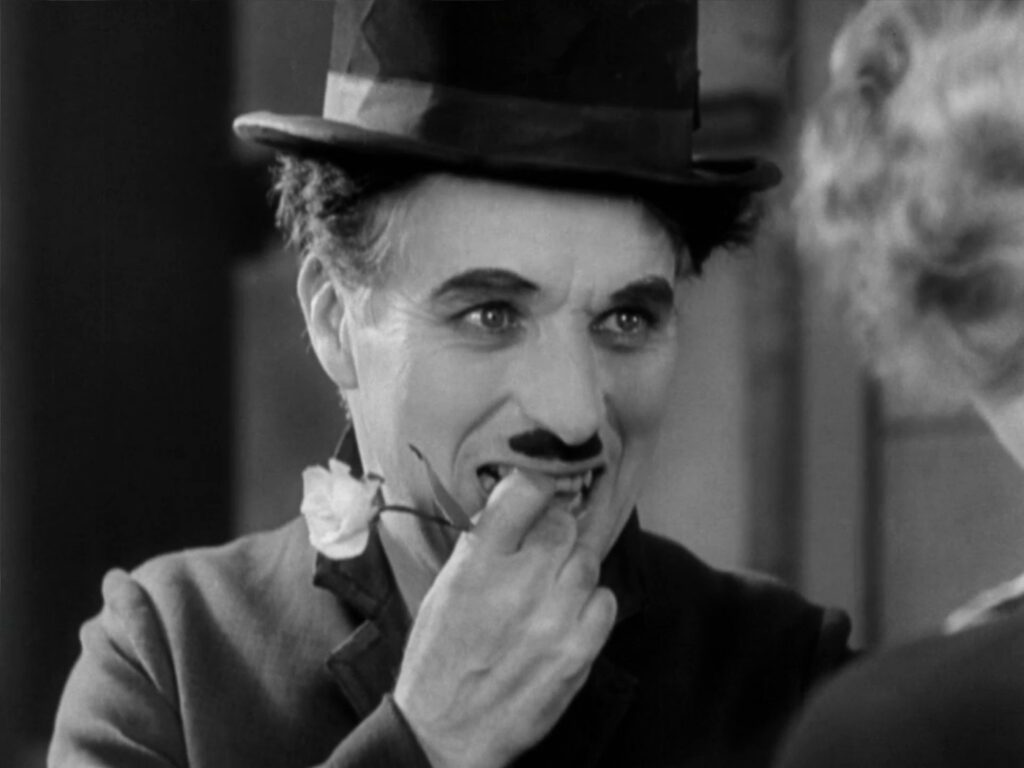
City Lights
1931, directed by Charles Chaplin
City Lights opens with three scenes built around female figures – a monument, a nude mannequin, and the Blind Girl. The progression from two statues to a real woman suggests a coming-to-life. First of all the plot comes to life, as the first two scenes are mere gags disconnected from the story, but this series of three women also charts a progression in the Tramp’s character. When we first see him, cradled in the lap of the monument’s central statue, he’s like an infant at his mother’s bosom. In the next scene, trying to pretend he’s not leering at the sexy statue, he’s like a pubescent boy. In the third scene he finally sees a woman as a human being like himself. The three opening vignettes therefore describe an arc of maturity.
What’s odd about this, however, is that it doesn’t seem to have much to do with the greater arc. City Lights does not appear to be a story of growing up. The Tramp will sacrifice money, opportunity, dignity, and freedom for the Blind Girl’s sake, but his selfless nature is already evident when he first meets her. The story, rather, traces an arc of increasing vision, although – again – it’s not so much the protagonist who learns to see better. The Tramp first appears in long shot, seen from across a crowd at the monument’s unveiling, and his first close-up comes at the very end. It’s as if we gradually come to see him in his full humanity. At first he’s a comic figure, just a funny little homeless man, but when we finally see him up close, he’s become so real that many viewers are moved to tears.
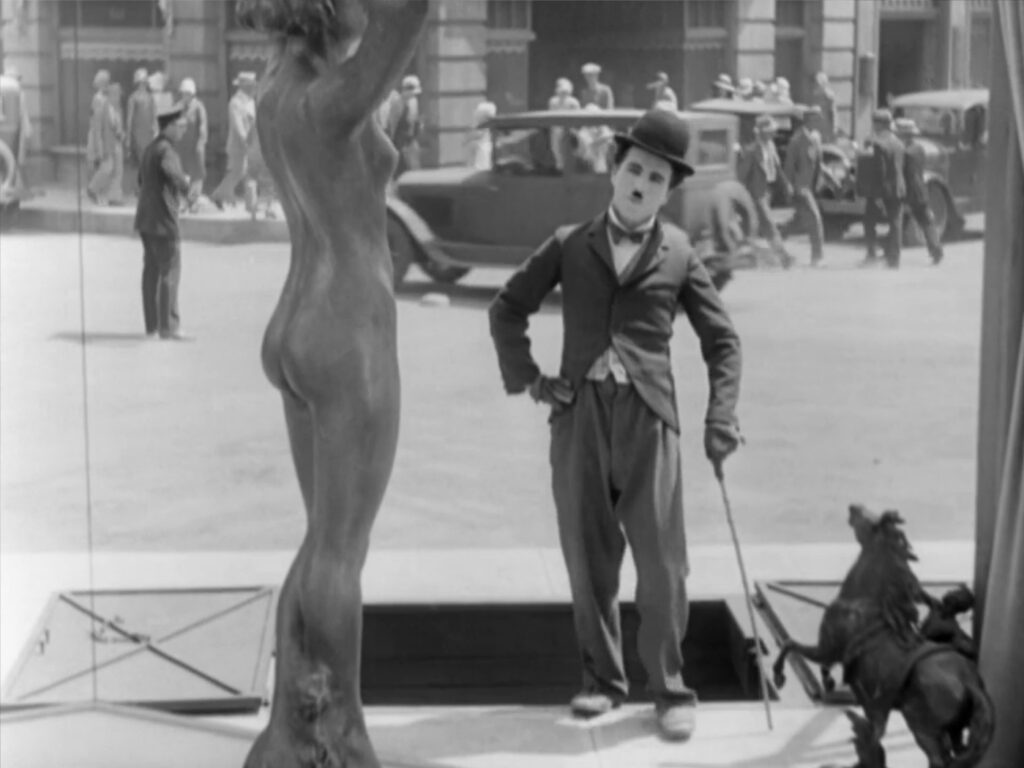
This would seem to accord with the famous quote ascribed to Chaplin by critic Richard Roud: “Life is a tragedy when seen in close-up, but a comedy in long-shot.” For all its pathos the ending isn’t exactly tragic – there’s exhilaration and hope in it – but the effect of the ending mirrors the quote. The same material of life can look radically different with a simple adjustment in point of view. Still, the adjustment of vision in City Lights is not just a matter of toggling between two camera placements. There’s a real sense of progress, of an improvement in vision, as the perspective moves closer, just as the Tramp’s view of women symbolically improves as he goes from the statues to a real live woman.
The bettering of vision is literal in the case of the Blind Girl, who finally gains her eyesight in an operation, but the idea of vision is also ingrained in the movie’s DNA. The film opens with an unveiling ceremony, exposing a monument to the vision of the masses, and it closes with the words: “You can see now?” “Yes, I can see now.” The word “Lights” in the movie’s title also points to vision.
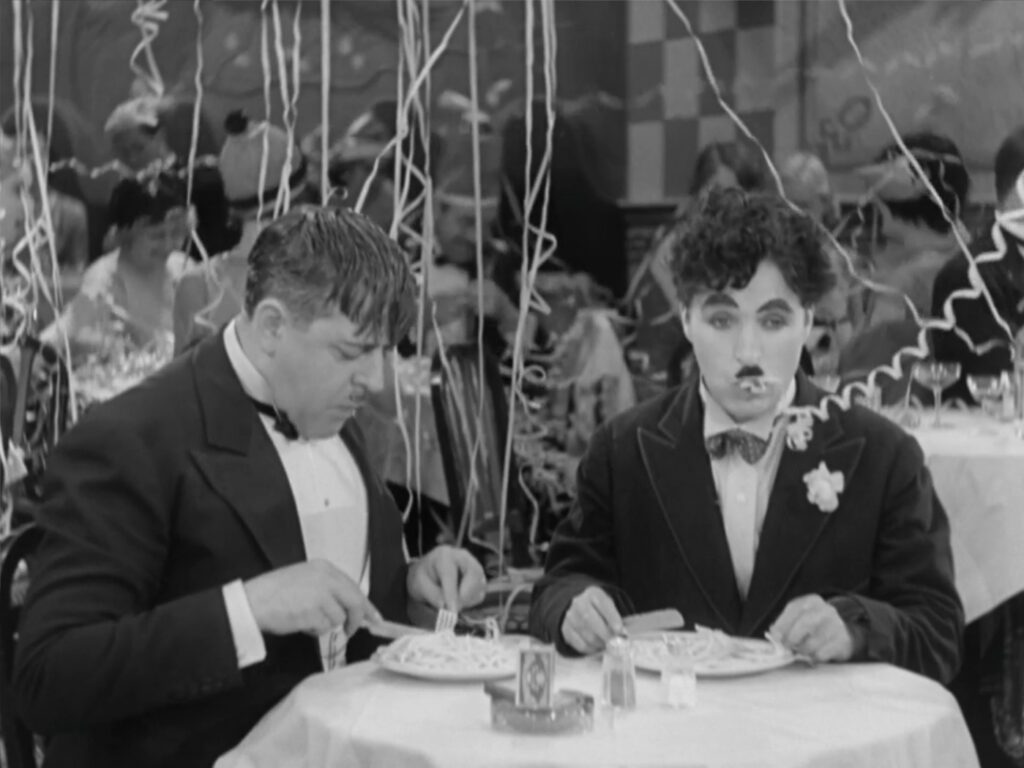
Almost every single joke calls attention to the obtuseness – the figurative blindness – that defines so many of our social relations. While eyeing the naked statue the Tramp is blissfully unaware of the trap door opening and shutting behind him. The millionaire only recognizes the Tramp when he’s drunk. In his stupor he pours a bottle of wine down the Tramp’s pants. Everyone at the nightclub is totally self-absorbed, leading to a cavalcade of misunderstandings and quarrels. The Tramp mistakes a stylized dance for a display of abuse and tries to defend the female partner. He chews on a streamer thinking it’s a strand of spaghetti. On the way home the millionaire doesn’t realize he’s driving his own car. When the Tramp looks into the Blind Girl’s window a neighbor misjudges his intent, causing him to upset a barrel of rainwater. Again at the party everyone is self-absorbed… the Tramp takes a bald head for an hors d’oeuvre, and no one realizes what’s happened when he swallows a whistle. At the work yard he and a co-worker mix up a bar of soap with a slice of cheese. No one realizes the Tramp doesn’t belong at the boxing club, and he only survives most of two rounds because his opponent focuses on the referee. The Tramp and the millionaire are blind to the burglars behind them, who in turn don’t realize that the Tramp is no threat, while the butler fails to see that the Tramp foils the crime.
Not all the obtuseness is comical. The Blind Girl thinks the Tramp is a wealthy man. The millionaire, blind to his own advantages, is ready to commit suicide out of self-pity. Society at large is blind to the humanity in the Tramp and the Blind Girl. Most of the world ignores the Tramp; the crowd at the statue’s unveiling wishes he’d go away; the teenage paperboys mock him mercilessly; he’s invisible at work and exploited in the boxing ring; the millionaire’s butler boots him out of the house at every opportunity; and the police misjudge him.
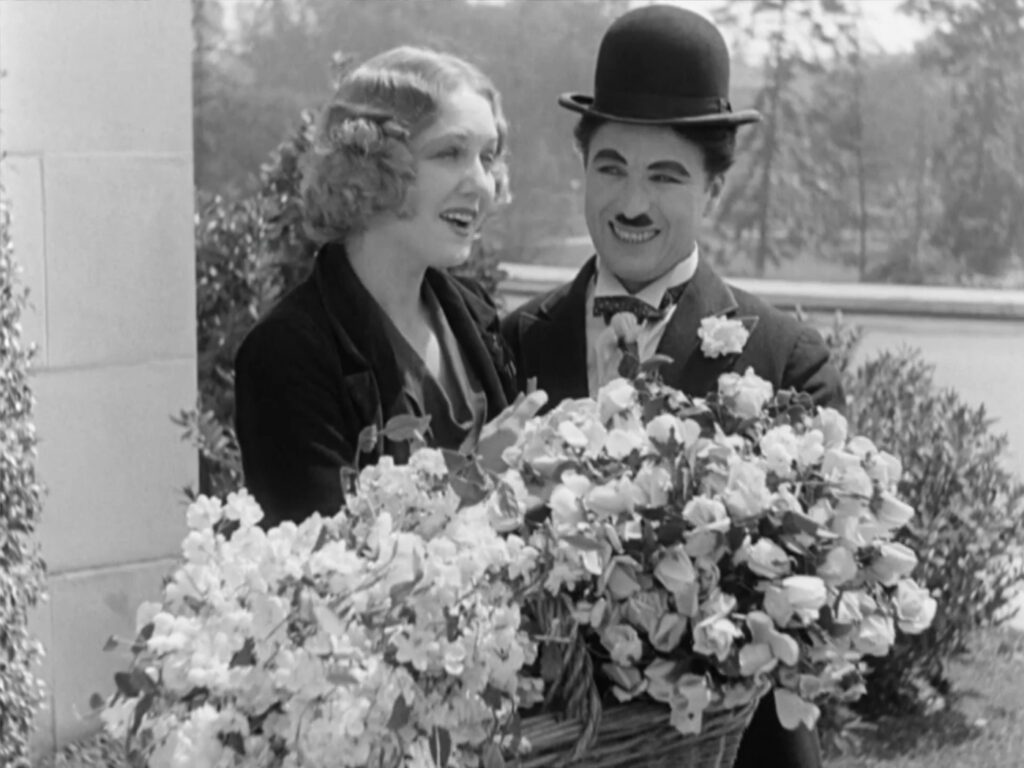
While half of the title calls attention to the idea of vision, the other half is important too. “City” is a shorthand for modern civilization, which, as all the obtuseness shows, does not put the same premium on vision that nature presumably does. People in a city often don’t see each other unless they interfere in the hectic stream of life. The title is written in light bulbs, in the style of a theater marquee, so that its light is a series of individual points instead of the pervasive sunlight or moonlight one would find in nature. Natural light has the generous effect of aiding vision, but the electric lights of a city are meant to draw attention. There’s also a diminished stability in the lights of a city… in the running jokes and rapid oscillations of fortune in City Lights, like the millionaire’s will to live or his friendship with the Tramp, there’s an on-and-off pattern like the flickering lights of an archetypal urban street.
City Lights was released roughly midway between the stock market crash of 1929 and the peak of the Great Depression, and although Chaplin had begun writing it well over a year before Black Thursday, its popularity must have been a testament to economic conditions in 1931. Chaplin had grown up in poverty, and he was sensitive to the socio-economic inequality of the Roaring Twenties. By 1931 a large part of the audience had caught up to his understanding of poverty, how a person like the Tramp or the Blind Girl could be invisible to society at large. The act of unveiling in the opening scene is thus a metaphor for the purpose of City Lights, which unveils the full humanity in one of these invisible people.
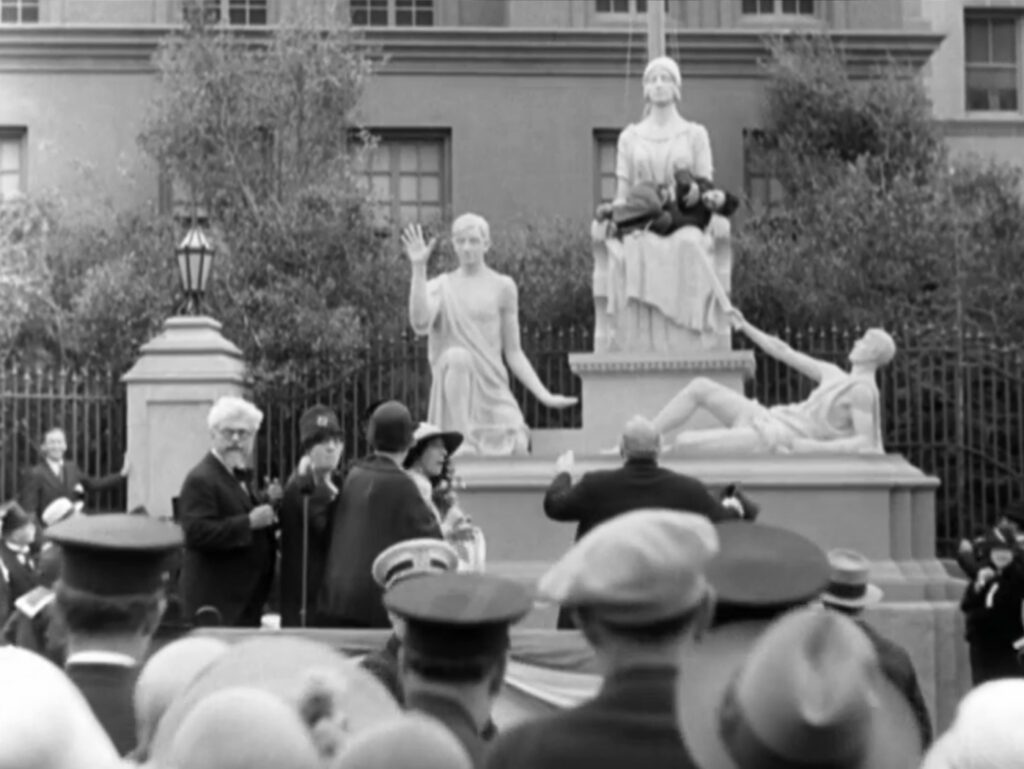
There’s an implicit joke in the unveiled monument. At first glance it’s a standard piece of urban pomp, but closer inspection reveals the absurdity of its composition. It’s designed solely as a framework for the series of gags as the Tramp descends from the central figure’s lap. The reclining figure’s sword catches the rear seat of the Tramp’s pants; its face becomes a vulgar resting place; and the raised hand of the opposite figure forms an irreverent gesture as the Tramp innocently ties his shoe. The dignitaries’ speeches are reduced to meaningless “womp-womp” sounds as if all we need to know is that they’re delivering boilerplate sentiments, blind to the supposedly humanistic intent of the sculpture.
The monument’s name “Peace and Prosperity” appears in the first intertitle, only nine seconds after the film’s title fades out – so early that the words would seem to carry an importance beyond satire. It’s obvious enough that society pays hypocritical lip service to the values of peace and prosperity, but the point of City Lights is to remind us of the genuine peace and prosperity we could achieve with a sharpened vision of the world around us. If we would only see all the humanity that we’re habitually obtuse to, then the world might change as radically as our view of the Tramp does between his first long shot and his close-up.
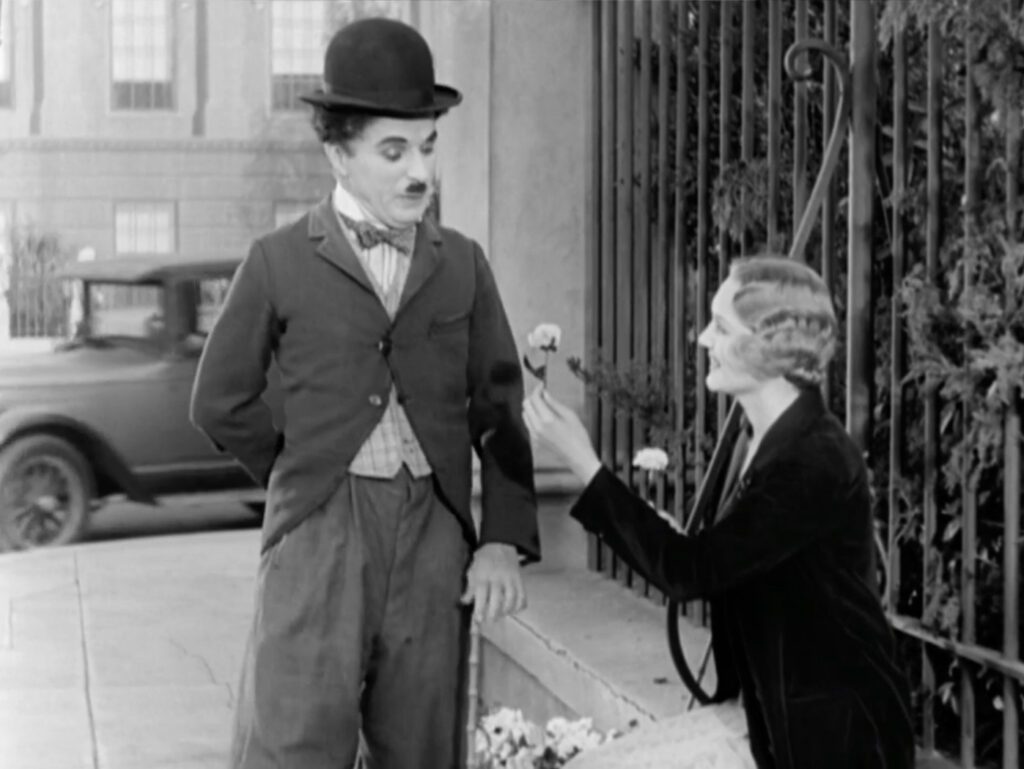
Now we can make sense of the three vignettes that start the film. From the maternal figure in the monument to the naked statue in the shop window to the living Blind Girl, the Tramp not only matures but comes to see his world with a wholeness of vision. In the following scenes he’ll often mirror the obtuseness that’s so typical of city life, but only in the small ways. Although he occupies the lowest position in society, his vision is greater than anyone else’s. The opening scenes do not forecast any transformation in his character; rather they point the way to a possible change in society as a whole. If more people shared the Tramp’s sense of vision, then civilization itself would grow up.
CONNECTIONS:
Modern Times – Second word of the title points to the film’s key
Monsieur Verdoux – Gentle soul in a harsh world; reversal in the protagonist’s response to the world
Roman Holiday – Real intimacy only possible at the end when the man and woman know the truth about each other
Tokyo Story – Intricately structured film with a highly emotional ending
Red Desert – Bracketed by images that describe an arc of increasing vision (one going from long shot to close-up, the other from blurry to focused)
I Knew Her Well – Saintly protagonist ignored and misunderstood by society
Blow-Up – Story defined by an arc of improved vision, with a lesson in seeing the world better
Dancer in the Dark – Saintly protagonist ignored and misunderstood by society; blindness as a metaphor; emotional ending
The Day He Arrives – Only close-up comes at the end as a sign of revelation